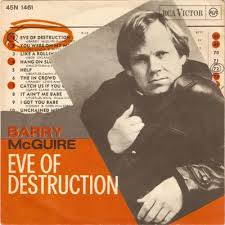 Two events from last week are of note for our California workforce community and more general California public affairs community: the latest monthly job numbers, and the passing away of the P.F. Sloan a Southern California songwriter whose songs included the 1965 hit “Eve of Destruction”. Let’s briefly explain, including their loose connection.
Two events from last week are of note for our California workforce community and more general California public affairs community: the latest monthly job numbers, and the passing away of the P.F. Sloan a Southern California songwriter whose songs included the 1965 hit “Eve of Destruction”. Let’s briefly explain, including their loose connection.
Last Friday’s state job numbers (for October 2015) continued the trend in California dating from February 2010 of steady job gains, and a declining unemployment rate. The state gained 41,200 jobs during the month, bringing the total job gains to 463,000 in just the past 12 months, and 2,131,800 jobs since February 2010. The unemployment rate declined to 5.8%. In 2010 it was above 12.5%.
The Bay Area generated by far the greatest number of jobs compared to population. The Bay Area has less than 20% of the state’s population, but generated more than 42% of the job gains. Santa Clara County had the greatest number among Bay Area counties adding 7600 jobs. George Avalos notes that the Santa Clara economy is now up to 1,071,400 payroll jobs, only a few thousand below the all-time county high set in December 2000. Santa Clara’s unemployment rate is now 3.9%–it was over 12% just a few years back.
The job growth statewide continues across sectors. Construction continues its ascent with a gain of 7600 jobs, up to 734,8000. Still a way from the more than 900,000 construction jobs we had in California in 2007, but up nearly 50,000 construction jobs over the past year. Manufacturing continues to hang in, no movement over the month, but still at 1,268,800 jobs.
On Sunday, Los Angeles Times columnist Steve Lopez presented a different picture with a column entitled “Rosy jobs numbers blind us to the bleak reality of the ‘real economy'”. Lopez chronicled the job search of Martin Saldana. Saldana, 51, had worked for 29 years at the Boeing plant in Long Beach, when he was laid off in February. The Air Force veteran went through numerous job applications without success until he was hired last month sandblasting aircraft landing gear parts at a plant in Torrance. His pay is about a third of his former pay at Boeing, with no benefits. Other former co-workers from Boeing are in similar employment situations, unable to find replacement positions.
So which picture is more accurate? Saldana’s story is not unusual for workers over 50 in California today, not only in manufacturing but in virtually all fields. Replacing a steady job with benefits when you are over 50 in the state, is very difficult. It has been for some time, and is even more so today as the contingent economy expands.
At the same time, the state job numbers don’t lie, especially the payroll job numbers. For most workers, there are more opportunities today than a few years ago. Our California economy has cross-currents, even in this time of employment expansion—just as it has had cross-currents in previous boom times.
***
Last week Mickey Kaus noted the passing of P.F. Sloan, a songwriter in Southern California in the 1960s. Mickey’s write-up has a lot of good material. P.F. Sloan attended Fairfax High in the early 1960s and begin writing songs in his mid-teens. He co-wrote “I Found a Girl” for Jan and Dean and “Let Me Be” for the Turtles, and “Secret Agent Man” a hit for Johnny Rivers.
“Eve of Destruction” which he wrote in mid-1964 was recorded by Barry McGuire in 1965 and became one of his biggest hits. The lyrics are familiar protest folk song themes of the period: against the Vietnam War (“The eastern world it is exploding, Violence flarin’, bullets loadin”), nuclear war (“If the button is pushed, there’s no runnin’ away; There’ll be no one to save with the world in grave”), and racial discrimination (“Hate your next door neighbor, but don’t forget to say grace”). Here is Barry McGuire singing the song in 1965 on the television show “Hullabaloo”.
P.F. Sloan (born Philip Gary Schlein) wrote the song when he was only 19. He had several subsequent hits, but by the end of the 1960s his career in songwriting had largely ended. In his 2014 autobiography, he wrote of his battles with drugs and mental illness, and institutionalization.
“Eve of Destruction” doesn’t mention joblessness, among its ills. In this regard, it is like nearly all of the protest songs of the 1960s. In part this reflects the employment plenty of the time in California. In July 1965, when the song was released, unemployment statewide was at 6%. It would then go down to 4.8% in July 1966, and remain under 5% for most of the period through December 1969. California’s major industries, including its heavy manufacturing enterprises, were continuing to expand payrolls.
At this same time, the popular press and academic press were filled with warnings about the rosy employment numbers. Automation was a big concern among state employment officials; a fear that the evolving technology of the 1960s would be putting hundreds of thousands of California out of work permanently, including assembly line workers like Mr. Saldana. Inner city unemployment was seen as a tinderbox, ready to explode.
Even in this earlier boom time of the California, there were many of the same employment cross-currents we see today. “Don’t you understand what I’m tryin’ to say; Can’t you feel the fears I’m feelin’ today?”, as Mr. Sloan might have said.

